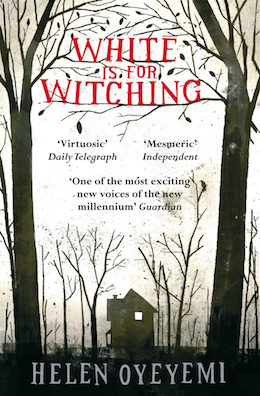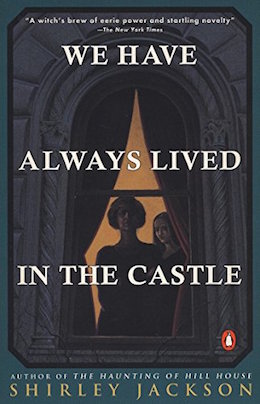December 14, 2016 marks the 100th anniversary of Shirley Jackson’s birth. To celebrate, we’re taking a look at some of her most memorable novels and short fiction.
Shirley Jackson’s We Have Always Lived in the Castle always bears rereading. Its strange, creeping prose, its charming protagonists, and its evocation of outsiderdom stand up to every memory or expectation you might have. Jackson didn’t pull any cheap shots with her horror. Even if the reveal at the end of the novel was a surprise to you, the richness of the mystery isn’t lost in hindsight. If anything, it highlights the cleverness of Jackson’s plotting, and makes the characters that much more pitiful, that much more horrifying.
One thing changed, though, between my first reading of Always Lived and my most recent one. In between, I read Helen Oyeyemi’s White is for Witching. I won’t be the first or the last to compare the two novels. They both feature old families in old houses, mysterious deaths and fear of outsiders, and both crawl under your skin with every new scene. But White is for Witching isn’t a straightforward retelling or inspired-work: it’s about racism, it’s about nationalism, and it’s about the genuine horror of social change. And it’s impossible, after reading it, to look at We Have Always Lived in the Castle in the same way again.
“Poor strangers,” I said. “They have so much to be afraid of.”
White is for Witching is about the Silver family and their home in Dover, England. Each successive generation of Silver women haunt one another and their home, scaring away any stranger that approaches. The house itself, a terrifying force, holds them there, luring each Silver woman into stagnation and madness. The problem, then, is that Miranda Silver’s father has turned the house into a bed and breakfast, inviting strangers and immigrants galore; the problem then, is that Miranda Silver has brought her new British-Caribbean girlfriend, Ore, home with her. And the house—and perhaps Miranda herself—will devour them.
 Superficial similarities and differences between Witching and Always Lived are immediately apparent. The madness and the isolation are the same, but the protagonist inviting an outsider into her home, rather than shunning them, is very different. The point that I want to make though, is the pair’s shared fear of the Other—in one case, the mob, the unwashed masses; in the other, the foreigner. The Silvers and the Blackwoods are both unchanging families in changing societies, stuck in their given hierarchies of class and of race. In Witching, this is a very clear and obvious critique, due in part to the story’s contemporaneity, its genre, and the reader’s assumptions about the author’s background. We Have Always Lived in the Castle—read even more as a straightforward horror novel now than when it was when it was released in 1962—is less often reduced to its social and political elements.
Superficial similarities and differences between Witching and Always Lived are immediately apparent. The madness and the isolation are the same, but the protagonist inviting an outsider into her home, rather than shunning them, is very different. The point that I want to make though, is the pair’s shared fear of the Other—in one case, the mob, the unwashed masses; in the other, the foreigner. The Silvers and the Blackwoods are both unchanging families in changing societies, stuck in their given hierarchies of class and of race. In Witching, this is a very clear and obvious critique, due in part to the story’s contemporaneity, its genre, and the reader’s assumptions about the author’s background. We Have Always Lived in the Castle—read even more as a straightforward horror novel now than when it was when it was released in 1962—is less often reduced to its social and political elements.
Unsettling and funny as Merricat Blackwood can be, though, readers shouldn’t let her unique voice distract them from her position. Wealthy and from an old, established family, Merricat’s hatred of the villagers is in huge part class-based. She describes them as gray and colorless, as a faceless mob, as dirty and undignified. Then there’s cousin Charles, a character who is comically deplorable in his greed and obsession with the Blackwood fortune. Charles is the very caricature of a modern capitalist, compared to the out-dated, “un-materialistic” family prestige the Blackwoods hold.
Neither Charles nor the villagers are presented in a sympathetic light—their misogyny and bullying are too profound for most readers to forgive the first time around. Yet, it’s undeniable that the Blackwoods are a dying class, and that they have (literally) destroyed themselves. This is what White is for Witching throws into such stark relief. While the protagonists of both novels are sympathetic, they are a part of a system of oppression, and it harms both them and the people around them. The Silvers and the Blackwoods are fighting the tides of history. However innocent a given character might be (debatable, in Merricat’s case), and however much they might love their family, that goodness cannot erase the horrors or cruelty of their reality. Neither book is reducible to their social commentary, of course, and I don’t meant to suggest that either is “about” oppression. For all their engaging plots and finely-crafted characters, though, the foulness of their underbellies is fully-based in real-world injustice.
And so what was meant to be a straightforward reread of We Have Always Lived in the Castle has in part turned into a review of White is for Witching. Yet Witching does what all the best transformative works should do: it not only reflects its source material, but forces its source material to reflect it. I recommend it without reservation, and yet I suggest even more strongly that you read the two back-to-back. What better way to spend the winter months, after all, than with books that will scare you in every possible manner.
Emily Nordling is a library assistant and perpetual student in Chicago, IL.










